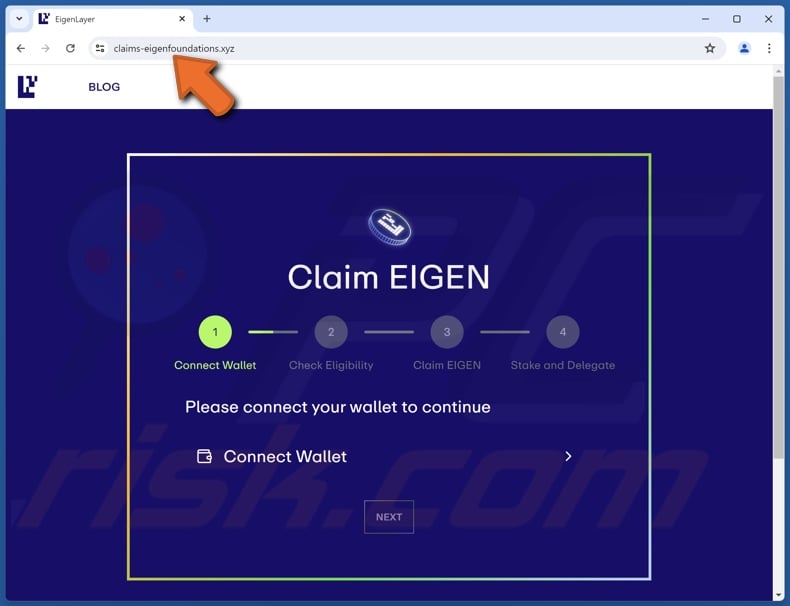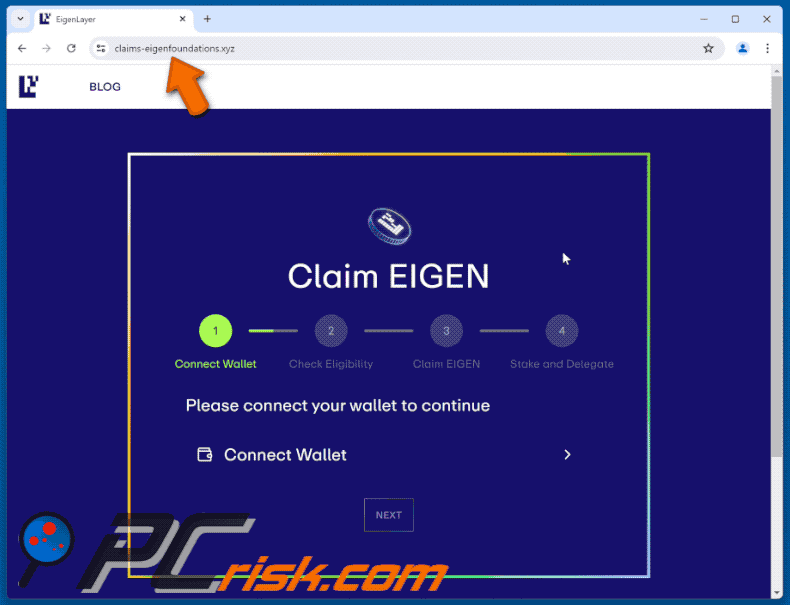Avoid losing digital assets through fake "Claim EIGEN" websites
Phishing/ScamAlso Known As: "Claim EIGEN" crypto drainer
Get free scan and check if your device is infected.
Remove it nowTo use full-featured product, you have to purchase a license for Combo Cleaner. Seven days free trial available. Combo Cleaner is owned and operated by RCS LT, the parent company of PCRisk.com.
What is the fake "Claim EIGEN" website?
"Claim EIGEN" is a scam promoted on claims-eigenfoundations[.]xyz (but it could be hosted on other domains). The scheme is supposedly distributing EIGEN tokens – instead, it functions as a cryptocurrency drainer. Essentially, the scam steals digital assets from victims' cryptowallets.
It must be emphasized that this fake giveaway is not associated with any existing platforms or entities.

IMPORTANT NOTE: We do not review crypto projects, please do your own research when investing money.
Federal Trade Comission (FTC) states that since the start of 2021, more than 46,000 people have reported losing over $1 billion in crypto to scams – that's about one out of every four dollars reported lost, more than any other payment method.
Fake "Claim EIGEN" website overview
We discovered this fake EIGEN airdrop promoted on claims-eigenfoundations[.]xyz, yet it could be hosted on other domains as well. This scam is presented as an EIGEN token giveaway. It must be reiterated that "Claim EIGEN" is fake, and it is in no way associated with any existing platforms/entities.
The scheme lures users into connecting their digital wallets, thus triggering the cryptocurrency-draining mechanism. Victims' funds are transferred to scammer-owned wallets in automated transactions that may appear vague. Some drainers can approximate the value of digital assets and prioritize their theft.
It must be mentioned that due to the practically untraceable nature of cryptocurrency transactions – they cannot be reversed.
| Name | "Claim EIGEN" crypto drainer |
| Threat Type | Phishing, Scam, Social Engineering, Fraud, Cryptocurrency Drainer |
| Disguise | EIGEN token airdrop |
| Related Domains | claims-eigenfoundations[.]xyz, claim-eigenfoundation-4xt.pages[.]dev |
| Detection Names | alphaMountain.ai (Spam), Forcepoint ThreatSeeker (Suspicious), Fortinet (Spam), Full List Of Detections (VirusTotal) |
| Serving IP Address | 104.21.12.36 |
| Distribution methods | Compromised websites, social media spam, rogue online pop-up ads, potentially unwanted applications. |
| Damage | Monetary loss |
| Malware Removal (Windows) |
To eliminate possible malware infections, scan your computer with legitimate antivirus software. Our security researchers recommend using Combo Cleaner. Download Combo CleanerTo use full-featured product, you have to purchase a license for Combo Cleaner. 7 days free trial available. Combo Cleaner is owned and operated by RCS LT, the parent company of PCRisk.com. |
Cryptocurrency drainer scam examples
"$FATTY Presale", "NEIRO Register", "Claim $METIS", and "Mint StoneAi" are just a few examples of crypto drainers. Aside from using draining mechanisms to steal funds from exposed wallets, cryptocurrency-specific scams can seek wallet log-in credentials or trick users into manually transferring assets to criminal-owned wallets.
It must be stressed that the Internet is rife with deceptive and malicious content. While online scams are often poorly made and full of mistakes, they can be competently crafted and even believably disguised as content linked to legitimate companies, organizations, institutions, and other entities.
How did I open a scam website?
Generally, online scams are promoted via websites that employ rogue advertising networks, spam (e.g., social media/ forum posts, emails, DMs/PMs, SMSes, browser notifications, etc.), malvertising (e.g., intrusive adverts), typosquatting (misspelled URLs), and adware.
Cryptocurrency drainers are often endorsed through intrusive pop-up advertisements. Some of these pop-ups are fully functional drainers; they entice users into "connecting" digital wallets by promising various boons. The advertisements in question have also been encountered on legitimate sites that had been compromised.
Another widespread promotional technique is social media spam. Promotional posts and direct/private messages can be made using hacked accounts (i.e., ones originally belonging to real project, companies, organizations, celebrities, influencers, etc.).
How to avoid visiting scam websites?
Caution is essential to online safety. Therefore, take note of URLs and enter them carefully. Be wary of ads making offers that sound too good to be true. Be selective when enabling websites to deliver browser notifications; do not permit suspicious pages to do so, and instead ignore or deny these requests (i.e., press "Block", "Block Notifications", etc.).
Do not use sites that offer pirated content or other dubious services (e.g., Torrenting, illegal streaming/downloading, etc.), as these webpages are usually monetized via rogue advertising networks. Be vigilant with incoming emails and other messages; do not open attachments or links found in suspect/irrelevant mail.
Download from official/trustworthy sources and approach installations carefully (e.g., study terms and options, use "Custom/Advanced" settings, and opt out of additional apps, tools, extensions, etc.) – to prevent bundled/harmful software (like adware) from infiltrating the system.
If your computer is already infected, we recommend running a scan with Combo Cleaner Antivirus for Windows to automatically eliminate all threats.
Appearance of the fake "Claim EIGEN" website (GIF):

Another example of Claim EIGEN scam website (claim-eigenfoundation-4xt.pages[.]dev):
![Claim EIGEN scam website (claim-eigenfoundation-4xt.pages[.]dev)](/images/stories/screenshots202410/claim-eigen-scam-update-2024-10-23-another-variant.jpg)
Instant automatic malware removal:
Manual threat removal might be a lengthy and complicated process that requires advanced IT skills. Combo Cleaner is a professional automatic malware removal tool that is recommended to get rid of malware. Download it by clicking the button below:
DOWNLOAD Combo CleanerBy downloading any software listed on this website you agree to our Privacy Policy and Terms of Use. To use full-featured product, you have to purchase a license for Combo Cleaner. 7 days free trial available. Combo Cleaner is owned and operated by RCS LT, the parent company of PCRisk.com.
Quick menu:
- What is "Claim EIGEN" crypto drainer?
- How to identify a pop-up scam?
- How do pop-up scams work?
- How to remove fake pop-ups?
- How to prevent fake pop-ups?
- What to do if you fell for a pop-up scam?
How to identify a pop-up scam?
Pop-up windows with various fake messages are a common type of lures cybercriminals use. They collect sensitive personal data, trick Internet users into calling fake tech support numbers, subscribe to useless online services, invest in shady cryptocurrency schemes, etc.
While in the majority of cases these pop-ups don't infect users' devices with malware, they can cause direct monetary loss or could result in identity theft.
Cybercriminals strive to create their rogue pop-up windows to look trustworthy, however, scams typically have the following characteristics:
- Spelling mistakes and non-professional images - Closely inspect the information displayed in a pop-up. Spelling mistakes and unprofessional images could be a sign of a scam.
- Sense of urgency - Countdown timer with a couple of minutes on it, asking you to enter your personal information or subscribe to some online service.
- Statements that you won something - If you haven't participated in a lottery, online competition, etc., and you see a pop-up window stating that you won.
- Computer or mobile device scan - A pop-up window that scans your device and informs of detected issues - is undoubtedly a scam; webpages cannot perform such actions.
- Exclusivity - Pop-up windows stating that only you are given secret access to a financial scheme that can quickly make you rich.
Example of a pop-up scam:

How do pop-up scams work?
Cybercriminals and deceptive marketers usually use various advertising networks, search engine poisoning techniques, and shady websites to generate traffic to their pop-ups. Users land on their online lures after clicking on fake download buttons, using a torrent website, or simply clicking on an Internet search engine result.
Based on users' location and device information, they are presented with a scam pop-up. Lures presented in such pop-ups range from get-rich-quick schemes to fake virus scans.
How to remove fake pop-ups?
In most cases, pop-up scams do not infect users' devices with malware. If you encountered a scam pop-up, simply closing it should be enough. In some cases scam, pop-ups may be hard to close; in such cases - close your Internet browser and restart it.
In extremely rare cases, you might need to reset your Internet browser. For this, use our instructions explaining how to reset Internet browser settings.
How to prevent fake pop-ups?
To prevent seeing pop-up scams, you should visit only reputable websites. Torrent, Crack, free online movie streaming, YouTube video download, and other websites of similar reputation commonly redirect Internet users to pop-up scams.
To minimize the risk of encountering pop-up scams, you should keep your Internet browsers up-to-date and use reputable anti-malware application. For this purpose, we recommend Combo Cleaner Antivirus for Windows.
What to do if you fell for a pop-up scam?
This depends on the type of scam that you fell for. Most commonly, pop-up scams try to trick users into sending money, giving away personal information, or giving access to one's device.
- If you sent money to scammers: You should contact your financial institution and explain that you were scammed. If informed promptly, there's a chance to get your money back.
- If you gave away your personal information: You should change your passwords and enable two-factor authentication in all online services that you use. Visit Federal Trade Commission to report identity theft and get personalized recovery steps.
- If you let scammers connect to your device: You should scan your computer with reputable anti-malware (we recommend Combo Cleaner Antivirus for Windows) - cyber criminals could have planted trojans, keyloggers, and other malware, don't use your computer until removing possible threats.
- Help other Internet users: report Internet scams to Federal Trade Commission.
Frequently Asked Questions (FAQ)
What is an online scam?
Basically, online scams are deceptive messages promoted on the Internet that seek to deceive users into performing certain actions. For example, victims may be lured into connecting digital wallets to crypto drainers, sending money to scammers, purchasing products, disclosing sensitive information, downloading/installing software, subscribing to services, and so forth.
What is the purpose of online scams?
Online scams are designed to generate revenue for scammers. Profit can be made by obtaining funds through deception, endorsing content (e.g., websites, products, services, etc.), abusing/selling vulnerable information, and spreading malware.
I have lost digital assets to the "Claim EIGEN" scam, can I get my money back?
Cryptocurrency transactions cannot be reversed because of their nearly untraceable nature. Therefore, victims of scams like this fake "Claim EIGEN" webpage cannot recover the stolen digital assets.
Why do I encounter online scams?
The most commonly used promotional methods include: spam (e.g., emails, SMSes, DMs/PMs, social media posts, browser notifications, etc.), websites using rogue advertising networks, mistyped URLs (typosquatting), intrusive ads (malvertising), and adware.
Will Combo Cleaner protect me from online scams?
Combo Cleaner can scan every website that you visit and detect rogue, deceptive, and malicious pages. Should you happen upon such a webpage – Combo Cleaner will immediately warn you and block all further access to it.
Share:

Tomas Meskauskas
Expert security researcher, professional malware analyst
I am passionate about computer security and technology. I have an experience of over 10 years working in various companies related to computer technical issue solving and Internet security. I have been working as an author and editor for pcrisk.com since 2010. Follow me on Twitter and LinkedIn to stay informed about the latest online security threats.
PCrisk security portal is brought by a company RCS LT.
Joined forces of security researchers help educate computer users about the latest online security threats. More information about the company RCS LT.
Our malware removal guides are free. However, if you want to support us you can send us a donation.
DonatePCrisk security portal is brought by a company RCS LT.
Joined forces of security researchers help educate computer users about the latest online security threats. More information about the company RCS LT.
Our malware removal guides are free. However, if you want to support us you can send us a donation.
Donate
▼ Show Discussion